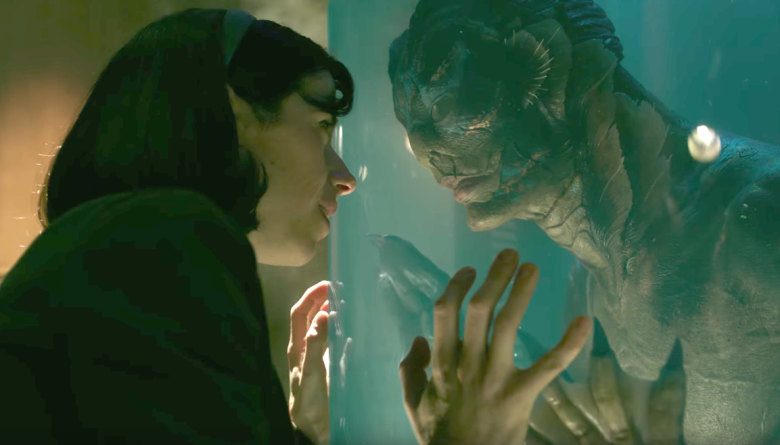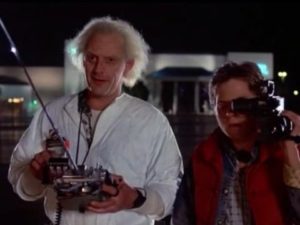‘The Shape of Water’ dives into thematic success
Elisa Esposito, played by Sally Hawkins, begins to form a meaningful bond with a tanked sea creature. “The Shape of Water,” praised for its novel storyline, skilled cast, and display of technical prowess, has received 13 Oscar nominations for the 2018 Academy Awards.
January 31, 2018
“Monsters are our way of making sense of imperfection.”
These are the words that Mexican director Guillermo del Toro said in response to winning the 2018 Golden Globes award for Best Director with regard to his latest film, “The Shape of Water.” Known for his expertise in directing a diverse range of films, such as “Pan’s Labyrinth” and “The Devil’s Backbone,” del Toro devotes his creativity to creating monsters that individuals can recognize themselves in and admire for their vulnerability that renders them beautiful.
“The Shape of Water” is no exception to del Toro’s prowess in filmmaking. With an exceptional cast, vivid cinematography, and a refreshing screenplay, “The Shape of Water” combines elements of fantasy, horror, and romance to deliver a touching story that will leave a lasting impact on viewers.
Set in Baltimore, Md., during the Cold War era, “The Shape of Water” focuses on the daily life of Elisa Esposito (Sally Hawkins), a reserved, mute woman who works as a janitor at an obscure government facility. Alongside Esposito is Giles (Richard Jenkins), her humorous, gay neighbor who faces difficulty in reviving his artistic career, and Zelda (Octavia Spencer), her loyal co-worker and interpreter who never hesitates to lend a helping hand. After Colonel Richard Strickland (Michael Shannon) brings a tanked sea creature (Doug Jones) to the facility for Dr. Robert Hoffstetler (Michael Stuhlbarg) to inspect, Esposito begins to secretly visit and develop a meaningful bond with him. Esposito’s admiration for the amphibian man ultimately serves as the driving force behind her goal to protect him from Strickland’s malicious intentions.
An inferred theme in the film is Elisa’s feelings of inadequacy in her life. Although Elisa is not entirely dissatisfied with her environment, her inability to speak makes her feel out of tune with the world. Despite living with a disability that alienates her from those around her, Elisa aspires to experience the same things every individual longs for: unconditional love, understanding, and, above all, a sense of belonging.
While Elisa’s search for a deeper connection alone is largely relatable for the majority of viewers, Hawkins also excels at bringing her character to life on screen. The role that Hawkins plays poses several limitations, including being unable to vocalize her thoughts, but she overcomes this obstacle exceptionally well. Through dynamic facial expressions and hand movements, Hawkins provides an engaging, emotion provoking performance that will make viewers smile during certain scenes and come close to shedding tears in others.
Shannon is another actor that displays considerable talent. With consideration to his role as Richard Strickland, Shannon once again gets to play the villain on screen, and he does so with great expertise. Although the ambition and questionable intentions of Shannon’s character reflect the characteristics of the stereotypical villain, his cool temper and self-assured composure make him a force to be reckoned with. Throughout the majority of the film, Shannon makes his character’s points across in a concise yet intimidating manner that will send shivers down one’s spine.
The remainder of the cast provides commendable performances. With her engaging dialogue, admirable humor, and overall vivacious presence in mind, there is no doubt that Spencer brings life to the film. Jenkins and Stuhlbarg also offer decent performances, albeit not as memorable as the ones executed by their co-stars.
Similarly, the cinematography of “The Shape of Water” is nothing short of breathtaking. It is characterized by a predominance of rich blue and cyan undertones, although other color palettes are also seen throughout the film. While the usage of blue and cyan is reserved for the presentation of Elisa’s world, the homes belonging to the supporting characters are depicted in warm colors. The cinema and recollection of love are defined by a red palette, and every aspect of the future consists of green undertones.
One of the most laudable aspects of “The Shape of Water” is its film score. When developing the music for the film, composer Alexandre Desplat found inspiration in the way water sounds and feels against one’s skin. He recalls how being in the midst of warm Caribbean water is comparable to experiencing love. “[Water] takes the shape of everything. It goes through the air, it’s invisible, it’s transparent, but it still has a lot of power,” Desplat said.
Not only is Desplat successful in transforming his vision into reality, but he also manages to compose music that blends seamlessly into the film. With the intention of making the viewer experience the sensation of being underwater, Desplat primarily works with the melodies of the accordion, flute, and whistle to produce an array of musical masterpieces.
Additionally, the set design and computer graphics of the film are meticulously thought out. Del Toro and the remainder of “The Shape of Water” team excel at immersing the viewer into a fantasy-like universe that can easily be perceived as reality. Even the leading actor of the film, a digitized amphibian man, manages to fit into his surroundings without a glare.
Aside from the physical aspects of the film, “The Shape of Water” does a superb job at reflecting its intended time period. By providing a glimpse of the homophobia faced by Giles as well as the subtle racism experienced by Zelda, the film confirms the prevalence of these issues in both the mid-20th century and today’s society. However, it is the differences of Elisa and her friends that allow them to join forces and work together toward a common goal — rescuing the sea creature.
“The Shape of Water” is a refreshing film worth watching. It is no surprise that the modern fairytale has reached the acclaim it has, including receiving 13 Oscar nominations for this year’s Academy Awards. It notably consists of an accomplished group of actors, alluring cinematography, and, above all, heart-warming embrace of our personal qualities that we perceive as inferior.








